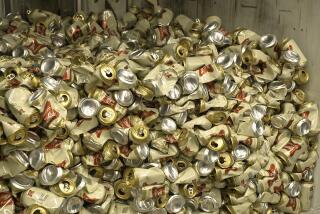Listeriosis Scare Sends Shiver Through French Town That Is Famous for Its Cheese
- Share via
CAMEMBERT, France — A British warning that Camembert cheese could contain dangerous bacteria sent a shiver through this sleepy Normandy hamlet, birthplace of one of the world’s most famous cheeses.
The threat to sales was felt even more acutely a few miles up the road in the village of Vimoutiers, where massive factories turn out the vast majority of Camembert production and employ most of Camembert’s 200 inhabitants.
The health scare has subsided but is not forgotten in a region that produces 160 million boxes of Camembert cheese a year.
In the hamlet of Camembert itself, only two farmers make the cheese by hand, a nine-stage process that results in a cheese bearing the “Appellation Controlee” label usually used as a guarantee of good French wine.
The two cheese makers, Michel Delorme and Francois Durand, produce just 400 boxes of Camembert a day, compared to 10,000 produced daily in the industrial dairies in Vimoutiers.
“Tourists who come here are amazed by its size and lots of them roll up in the center of the hamlet and ask where Camembert is,” said Raymond Moiteaux, mayor of Camembert for 18 years until he was voted out of office last month.
A modest stone slab bearing the name of Marie Harel greets visitors at a crossroads close to the village.
Harel, who lived at the time of the French revolution 200 years ago, has gone down in history as the inventor of Camembert cheese, although historians point out the cheese was mentioned almost 100 years earlier by writer Thomas Corneille, brother of the playwright Pierre.
Legend has it that Harel hid a priest who refused to support the revolution in the vast chimney of her family’s house in Camembert. In return, the priest revealed the secret of the soft, creamy cheese with the white rind.
Emperor Napoleon III took a fancy to it when he was given some by Harel’s grandson, Victor Paynel, during a visit to Normandy in 1863. The emperor ordered a supply for himself, and Paris high society soon followed suit.
An American, Dr. Joseph Knirim, erected a statue of Harel in 1928.
Michel Delorme makes 200 cheeses a day, which sell at between $1.40 and $2 each.
Delorme, Camembert-born, switched from making Livarot, another well-known Normandy cheese, to Camembert seven years ago and has not had a day off since. “The cows don’t take a day off so neither can I,” he said.
Delorme, his wife and son have a herd of 35 cows and also make cider, like most farmers in Normandy. Milk plays a key role in their daily existence.
“The weather is all important for the milk. Milk changes depending on the weather. When, for example, it’s stormy and the cows start running around, then we have to work doubly hard because the milk is not as good,” Delorme said.
All real Camembert is made of unpasteurized milk. In fact, no self-respecting French shopper would think of buying cheese made from pasteurized milk.
Britain’s Chief Medical Officer Donald Acheson said in February that pregnant women should not eat soft cheeses such as Camembert, Brie and blue-veined cheese, saying infection from Listeria bacteria could cause miscarriage or stillbirth.
Belgium temporarily banned the sale of two French Camemberts 12 days later after discovering that they contained Listeria . The ban has since been lifted.
An outbreak of listeriosis that killed 25 people in 1987 was traced to a Swiss soft cheese.
France asked Britain to give its cheese a clean bill of health, although it did not dispute that the bacteria had been found in Belgium.
The warning and ban referred to cheese made from unpasteurized milk, as the bacteria does not survive processing.
European governments made reassuring noises about the cheese, and France indicated that it might take legal action against countries that persisted in saying its cheeses were dangerous.
More to Read
Eat your way across L.A.
Get our weekly Tasting Notes newsletter for reviews, news and more.
You may occasionally receive promotional content from the Los Angeles Times.










